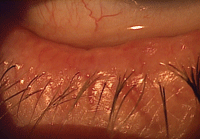 Meibomian gland dysfunction (MGD) is a common ocular condition and a primary cause of dry eye disease. However, because ongoing research is only now providing a clear understanding of MGD’s pathogenesis, many eye care providers remain widely uninformed about the newest and most effective treatment options. Here’s an overview of what you need to know.
Meibomian gland dysfunction (MGD) is a common ocular condition and a primary cause of dry eye disease. However, because ongoing research is only now providing a clear understanding of MGD’s pathogenesis, many eye care providers remain widely uninformed about the newest and most effective treatment options. Here’s an overview of what you need to know.
Liposome Spray
One report from the International Workshop on Meibomian Gland Dysfunction shed light on a rather novel therapy known as liposomal spray.1 This product delivers phospholipids to the tear film via the surface of closed eyelids. Upon application, the phospholipids penetrate the eyelids and reach the ocular surface to potentially help eliminate symptoms of MGD and evaporative dry eye.
In one study, patients with MGD were randomized to receive saline spray or Tears Again Advanced (Ocusoft) liposome spray.2 In the Tears Again Advanced group, 46% of patients reported increased comfort and exhibited improved lipid layer grades and tear film break-up times (TFBUTs), compared to just 18% in the saline group.2 Another study indicated that patients who received liposome spray showed better than a two-fold improvement in TFBUT compared to those who received artificial tears.2,3
Warm Compresses
Some impressive research published by Donald R. Korb, O.D., and associates in 2007 examined the impact of heat on the meibomian glands.4 The researchers suggested that, in order to optimize the therapeutic efficacy of warm compresses, patients should heat them to approximately 45°C, optimize contact between the compresses and the outer eyelid surface, and maintain contact for at least four minutes to achieve an inner lower eyelid temperature greater than or equal to 40°C.
Another landmark study looked at the effect of warm compress therapy on tear film lipid layer thickness (TFLLT) after five, 15 and 30 minutes of continuous contact with the eyelid surface.5 Previous studies have shown that TFLLT correlates well with patient symptoms, and that individuals with thinner lipid layers (<60nm) tend to have more severe dry eye symptoms.5
The mean TFLLT at baseline or prior to treatment was 57.8nm +/-12.9nm. After five minutes of treatment with warm compresses, TFLLT increased to 105.8nm +/-23.7nm; 117.8nm +/-26.4nm at 15 minutes; and 121.5nm +/-27.1nm at 30 minutes.6 The researchers concluded that warm, moist compresses increase TFLLT by more than 80% after just five minutes, and an additional 20% after 15 minutes.6
Some effective treatment options for MGD that use heat therapy include TranquilEyes (Ocusoft), Bruder Moist Heat Compresses (Bruder Healthcare) and the LipiFlow Thermal Pulsation System (TearScience).
TranquilEyes care kits include foam inserts that continuously heat and moisten the eye for more than 30 minutes. Bruder Moist Heat Compresses use moisture beads to maintain heat on the eyelid for more 20 minutes after being placed in the microwave.
Finally, the LipiFlow device incorporates moist, warm compresses with mechanical eyelid massage for 30 minutes. This relatively new technology works effectively on a variety of patients––ranging from those with significant MG dropout to obstructive MGD.7,8 A single LipiFlow Thermal pulsation system treatment may improve meibomian gland function and reduce dry eye symptoms for up to nine months.9
|
|

|
|
|
What’s the most effective treatment option for this patient with MGD?
|
Topical Therapeutic Options
Inflammation or meibomitis secondary to MGD may require treatment with topical antibiotics, corticosteroids and/or combination agents. However, because nonobvious obstructive MGD often presents without inflammation, is it wise to employ such therapeutic agents off-label?10
Certainly, there is evidence that inflammation is present in dry eye disease.11-16 Furthermore, researchers have estimated that 86% of patients with dry eye disease showed signs of MGD.17 But are there any specific studies on the role of inflammation in evaporative dry eye disease that are most commonly caused by MGD?
In one noteworthy study, researchers compared 23 patients with known mild-to-moderate evaporative dry eye disease with nine healthy subjects.18 In both groups, 15 cytokines and chemokines were measured by multiplex bead analysis. The results showed that 14 of 15 inflammatory molecules were reliably detected in 1µl of tears from patients with evaporative dry eye disease.18 Many of the cytokines actually could be correlated with specific symptoms, such as heightened volumes of interleukin-6 and increased levels of pain. These data suggest that anti-inflammatory medications could be useful in managing patients with evaporative dry eye and/or MGD.
In another study, a combination treatment of azithromycin and warm compress therapy effectively alleviated meibomian gland plugging, increased meibomian secretion volume and reduced eyelid redness compared to the application of warm compresses alone.19 A separate study showed that MGD patients who used Restasis (cyclosporine 0.05%, Allergan) exhibited fewer meibomian gland inclusions than those who received a placebo.20
Some of the other most commonly used therapeutic options for MGD include combination agents, such as Zylet (loteprednol etabonate and tobramycin, Bausch + Lomb) and Tobradex ST (tobramycin and dexamethasone, Alcon), as well as steroidal ointments, such as Tobradex (tobramycin and dexamethasone ophthalmic ointment, Alcon) and Lotemax (loteprednol etabonate ophthalmic ointment, Bausch + Lomb).
Although none of these medications have a specific indication for MGD, they demonstrate significant therapeutic success in clinical practice.
Oral Doxycycline
Oral doxycycline is often used to treat MGD. It is interesting to note, however, that doxycycline is not detectable in the tear film of patients who are undergoing treatment.21 So, perhaps the agent works either directly on the eyelid tissue or systemically to reduce inflammation.22
Gland Expression and Probing
Research has shown that aqueous tear evaporation diminishes following meibomian gland expression in patients with dry eye disease and/or MGD.23 Typically, the pressure required to properly express the meibomian glands ranges from 5psi to 40psi for the initial non-liquid material and 10psi to 40psi for the remaining contents.24 So, expression tools, such as the Mastrota Meibomian Gland Paddle (Ocusoft), Collins Expressor Forceps (Bruder Healthcare) and the MG Expressor Kit (Gulden Ophthalmics), may play an important role in successful care. Unfortunately, however, one study indicated that just 7% of patients could tolerate the pain required to administer complete expression along the entire lower eyelid margin.24
One additional question: Is there therapeutic benefit in intraductal meibomian gland probing? One study showed that the process relieved the symptoms of obstructive MGD in 25 consecutive patients.25 However, further research may be needed to observe the long-term benefits over time, and to make certain that the more invasive technique does not damage the glands.
The Future of MGD Treatment
Future MGD treatments include the use of pulsed-light therapy on the eyelids as well as new therapeutic agents that affect cytokines and inflammatory T-cells.
Another potentially unique treatment option includes androgen therapy.26 One study from Schepens Eye Research Institute showed that androgen regulation of gene expression exists in human meibomian glands.27 The researchers showed that androgens, such as dihydrotestosterone, exert a significant influence on the structure, function and pathophysiology of the meibomian glands and may play a key role in the treatment of MGD.
Today, the acronym MGD is a true “buzz word” in the eye care community. During the last several years, this overwhelming interest has fostered a widely improved understanding of the condition. With additional clinical study during the next decade, researchers and physicians likely will uncover a host of new treatment options to help patients with this chronic condition that affects visual quality, personal appearance and overall quality of life.
Dr. Karpecki is a paid consultant and/or advisor to Allergan, Alcon, Bausch + Lomb and Ocusoft. Neither he nor Dr. Shechtman have any direct financial interests in the products mentioned.
1. Geerling G, Tauber J, Baudouin C, et al. The International Workshop on Meibomian Gland Dysfunction: report of the Subcommittee on Management and Treatment of Meibomian Gland Dysfunction. Invest Ophthalmol Vis Sci. 2011 Mar 30;52(4):2050-64.
2. Craig JP, Purslow C, Murphy PJ, Wolffsohn JS. Effect of a liposomal spray on the pre-ocular tear film. Cont Lens Anterior Eye. 2010 Apr;33(2):83-7.
3. Khaireddin R, Schmidt KG. Comparative investigation of treatments for evaporative dry eye. Klin Monbl Augenheilkd. 2010 Feb;227(2):128-34.
4. Solomon JD, Case CL, Greiner JV, et al. Warm compress induced visual degradation and Fischer-Schweitzer polygonal reflex. Optom Vis Sci. 2007 Jul;84(7):580-7.
5. Blackie CA, Solomon JD, Scaffidi RC, et al. The relationship between dry eye symptoms and lipid layer thickness. Cornea. 2009 Aug;28(7):789-94.
6. Olson MC, Korb DR, Greiner JV. Increase in tear film lipid layer thickness following treatment with warm compresses in patients with MGD. Eye Contact Lens. 2003 Apr;29(2):96-9.
7. Korb DR, Blackie CA. Case report: a successful LipiFlow treatment of a single case of MGD and dropout. Eye Contact Lens. 2012 Mar 12. [Epub ahead of print]
8. Friedland BR, Fleming CP, Blackie CA, et al. A novel thermodynamic treatment for meibomian gland dysfunction. Curr Eye Res. 2011 Feb;36(2):79-87.
9. Greiner JV. A single LipiFlow Thermal pulsation system treatment improves meibomian gland function and reduces dry eye symptoms for 9 months. Curr Eye Res. 2012 Apr;37(4):272-8.
10. Blackie CA, Korb DR, Knop E, et al. Nonobvious obstructive meibomian gland dysfunction. Cornea. 2010 Dec;29(12):1333-45.
1. Pflugfelder SC, Jones D, Ji Z, et al. Altered cytokine balance in the tear fluid and conjunctiva of patients with Sjögren’s syndrome keratoconjunctivitis sicca. Curr Eye Res. 1999 Sep:19(3):201-11.
2. Tishler M, Yaron I, Geyer O, et al. Elevated tear interleukin-6 levels in patients with Sjögrens syndrome. Ophthalmology. 1998 Dec;105(12):2327-9.
3. Massingale ML, Li X, Vallabhajosyula M, et al. Analysis of inflammatory cytokines in the tears of dry eye patients. Cornea. 2009 Oct;28(9):1023-7.
4. Lam H, Bleiden L, De Paiva CS, et al. Tear cytokine profiles in dysfunctional tear syndrome. Am J Ophthalmol. 2009 Feb;147(2):198-205.
5. Yoon KC, Jeong IY, Park YG, Yang SY. Interleukin-6 and tumor necrosis factor-alpha levels in tears of patients with dry eye syndrome. Cornea. 2007 May;26(4):431-7.
6. Solomon A, Dursun D, Liu Z, et al. Pro- and anti-inflammatory forms of interleukin-1 in the tear fluid and conjunctiva of patients with dry-eye disease. Invest Ophthalmol Vis Sci. 2001 Sep;42(10):2283-92.
7. Lemp MA, Crews LA, Bro AJ. Distribution of aqueous-deficient and evaporative dry eye in a clinic-based patient cohort: a retrospective study. Cornea. 2012 May;31(5):472-8.
8. Enriquez-de-Salamanca A, Castellanos E, Stern ME, et al. Tear cytokine and chemokine analysis and clinical correlations in evaporative-type dry eye disease. Mol Vis. 2010 May 19;16:862-73.
19. Luchs J. Efficacy of topical azithromycin ophthalmic solution 1% in the treatment of posterior blepharitis. Adv Ther. 2008 Sep;25(9):858-70.
20. Perry HD, Doshi-Carnevale S, Donnenfeld E. Efficacy of commercially available topical cyclosporine A 0.05% in the treatment of MGD. Cornea. 2006 Feb;25(2):171-5.
21. Smith VA, Khan-Lim D, Anderson L, et al. Does orally administered doxycycline reach the tear film? Br J Ophthalmol. 2008 Jun;92(6):856-9.
22. Federici RJ. The non-antibiotic properties of tetracyclines: clinical potential in ophthalmic disease. Pharmacol Res. 2011 Dec;64(6):614-23.
23. Arciniega JC, Wojtowicz JC, Mohamed EM, et al. Changes in the evaporation rate of tear film after digital expression of meibomian glands in patients with and without dry eye. Cornea. 2011 Aug;30(8):843-7.
24. Korb DR, Blackie CA. Meibomian gland therapeutic expression: quantifying the applied pressure and the limitation of resulting pain. Eye Contact Lens. 2011 Sep;37(5):298-301.
25. Maskin SL. Intraductal meibomian gland probing relieves symptoms of obstructive meibomian gland dysfunction. Cornea. 2010 Oct;29(10):1145-52.
26. Khandelwal P, Liu S, Sullivan DA. Androgen regulation of gene expression in human meibomian gland and conjunctival epithelial cells. Mo Vis. 2012;18:1055-67.

